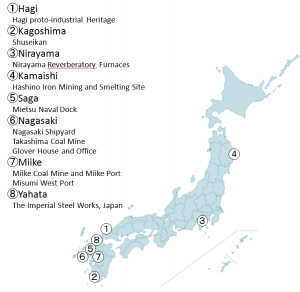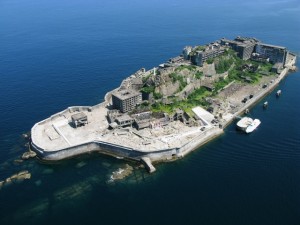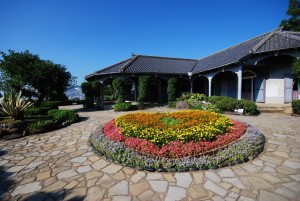In July 2005, Kagoshima Prefecture organized a congress on the theme of “Industrial heritage reflecting the modernization process in Kyushu”. “The declaration of Kagoshima” was written at the end of the congress and in June 2006, the governors of the Kyushu prefectures met to designate “the preservation and enhancement of industrial heritage reflecting Kyushu’s modernisation process” as one of the priority topics of a common heritage policy.
In October 2008, local authorities hosting the sites sent delegates to the nomination committee to support World Heritage listing, resulting in September 2009 with the sites being on the list of provisional candidates. In April 2013, the draft letter of recommendation written with the support of the candidacy committee was then given to the Japanese government. In January 2014, the Japanese government sent its recommendation letter to the Unesco World Heritage Centre. In 2015, meeting in Bonn for its 39th session, the World Heritage Committee made the decision to list the sites proposed on the Representative List of World Heritage.
Finally on July 8, 2015, the registration was formalized under the designation “Sites of the Meiji Japan industrial revolution: steel industry, shipbuilding and coal mining”.
MEIJI INDUSTRIAL REVOLUTION SITES: STEEL, NAVAL INDUSTRY, CONSTRUCTION AND COAL MINING
The sites on the List of World Heritage in July 2015 illustrate the process by which Japan was able to acquire technology from the West and became industrialized, adapting the technologies to Japanese needs and social traditions. It was the first time in history that the western industrial model was adopted by a non-Western nation. The push for registration was from a regional level with the leadership of the local authorities in the areas where the sites are situated.
From the second half of the 19th century to the early 20th century, in the Japanese era classification from the end of the Edo period at the beginning of the Meiji period, Japan experienced rapid industrial development, based on steel, shipbuilding and coal mining. The earliest testing of canons and construction of western-style boats were inspired by Dutch books that arrived in Japan through the Dutch trading post at Dejima. Later, young Japanese made the trip to Europe to adopt Western technologies. By the end of the Meiji period, home grown engineers were prevalent in Japan.
Without ever becoming a colony, and in the space of just 50 years, Japan was the first non-Western nation to go through an industrial revolution. This remarkable transformation is an important episode in Japanese and world history.
The 23 sites selected for World Heritage listing are spread over eleven cities in eight prefectures. Yamaguchi Prefecture, close to the island Kyushu, is home to the greatest number.
THE PROCESS OF THE INDUSTRIAL REVOLUTION IN JAPAN
The process adopting Western technology dates back to the time of the Opium War (1839-1842). Japan rulers were shocked to see China’s Qing Dynasty bow to the UK, a small European island country. At that time, the government forbade shogun era trade relations with foreign countries except China and the Netherlands. All foreign trade passed through the port of Nagasaki, under the control the fiefdom of Saga. The English had steamers and guns that allowed them to attack from a distance. The Chinese struggled to resist them. Faced with this threat, Japan was forced into action and the stronghold of Saga was the first to undertake building of its own guns and warships.
Other Japanese ‘domains’ reacted to the outside world in different ways. The Choshu Five went on a study mission and left Japan in 1863, as five young vassals of the domain of Choshu (corresponding to a part of the current prefecture of Yamaguchi). Among them was Ito Hirobumi who later became the prime minister of the first government of Japan of the Meiji era, as well as Yamao Yozo who dreamt of one day building steamboats in Japan, who went to work at the Napier shipyard in Glasgow, Scotland.
In July 1865, a group of 15 left the domain of Satsuma. Upon arrival in London, the students from Satsuma domain made out from King’s Cross train station on the Great Northern Railway Company to get to the Britannia metallurgical plant in Bedford. Among them was Godai Tomoatsu, who became famous as a great entrepreneur in Osaka upon his return, founding the Osaka Chamber of Commerce and the Osaka Stock Exchange.
The shogunate government was ousted in 1868 because of poor choices of domestic and foreign policy. It was under the government established after the Meiji Restoration that these modern industries were applied which launched the country into a new era.
HERITAGE TO PRESERVE FOR FUTURE GENERATIONS
The World Heritage sites are shared heritage for all of humanity that must be safeguarded and passed on to future generations. Alongside the conservation measures implemented, the relevant local authorities worked in partnership with government organizations on different initiatives to promote knowledge of sites so that their outstanding universal value and nature can be enjoyed by a wide public, both Japanese and overseas.
More information can be found, with details of each of the sites, on the UNESCO website here
Sign up on our website homepage to receive our eNews updates




